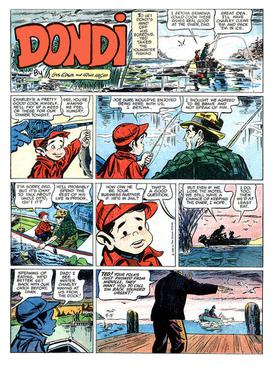
Dilbert is an American comic strip written and illustrated by Scott Adams, first published on April 16, 1989. It is known for its satirical office humor about a white-collar, micromanaged office with engineer Dilbert as the title character. It has led to dozens of books, an animated television series, a video game, and hundreds of themed merchandise items. Dilbert Future and The Joy of Work are among the best-selling books in the series. In 1997, Adams received the National Cartoonists Society Reuben Award and the Newspaper Comic Strip Award for his work. Dilbert appears online and as of 2013 was published daily in 2,000 newspapers in 65 countries and 25 languages.
Dennis the Menace may refer to either of two comic strip characters that both appeared in March 1951, one in the UK and one in the US.

Jennifer Jane Saunders is an English actress, comedian, singer, and screenwriter. Saunders originally found attention in the 1980s, when she became a member of The Comic Strip after graduating from the Royal Central School of Speech and Drama with her best friend and comedy partner, Dawn French. With French, she co-wrote and starred in their eponymous sketch show, French and Saunders, for which they jointly received a BAFTA Fellowship in 2009. Saunders later received acclaim in the 1990s for writing and playing her character Edina Monsoon in her sitcom Absolutely Fabulous.

Dondi was a daily comic strip about a large-eyed war orphan of the same name. Created by Gus Edson and Irwin Hasen, it ran in more than 100 newspapers for three decades.
Topper or Toppers may refer to:

Mutt and Jeff is a long-running and widely popular American newspaper comic strip created by cartoonist Bud Fisher in 1907 about "two mismatched tinhorns". It is commonly regarded as the first daily comic strip. The concept of a newspaper strip featuring recurring characters in multiple panels on a six-day-a-week schedule had previously been pioneered through the short-lived A. Piker Clerk by Clare Briggs, but it was Mutt and Jeff as the first successful daily comic strip that staked out the direction of the future trend.
Mastermind, Master Mind or The Mastermind may refer to:

King Features Syndicate, Inc. is an American content distribution and animation studio, consumer product licensing and print syndication company owned by Hearst Communications that distributes about 150 comic strips, newspaper columns, editorial cartoons, puzzles, and games to nearly 5,000 newspapers worldwide. King Features Syndicate also produces intellectual properties, develops new content and franchises, and licenses its classic characters and properties.
A cliffhanger is a plot device as an ending of a fictional work.

A topper in comic strip parlance is a small secondary strip seen along with a larger Sunday strip. In the 1920s and 1930s, leading cartoonists were given full pages in the Sunday comics sections, allowing them to add smaller strips and single-panel cartoons to their page.
Animal crackers are a snack of sweet crackers in animal shapes.
Joker(s) or The Joker(s) may refer to:
Marmaduke is a syndicated comic strip and the name of its main character, a Great Dane.

The Billy Ireland Cartoon Library & Museum is a research library of American cartoons and comic art affiliated with the Ohio State University library system in Columbus, Ohio. Formerly known as the Cartoon Research Library and the Cartoon Library & Museum, it holds the world's largest and most comprehensive academic research facility documenting and displaying original and printed comic strips, editorial cartoons, and cartoon art. The museum is named after the Ohio cartoonist Billy Ireland.

Room and Board is the title of two American comic strips. The first, created by Sals Bostwick, debuted on May 21, 1928. He drew it until his death in 1930, after which it was continued by cartoonists Brandon Walsh, Benbee, Darrell McClure, Dow Walling and Herman Thomas before coming to an end in 1932.
Red meat is meat that is red when raw and not white when cooked.
Blondie is a term sometimes used to refer to a person with blonde hair.

After George Herriman conceived the Krazy Kat comic strip in 1913, the title character began appearing in animated shorts three years later. From 1916 to 1940, Krazy Kat was featured in 231 films. The following is a list of the cartoons released theatrically, separated by studio.
This page is based on this
Wikipedia article Text is available under the
CC BY-SA 4.0 license; additional terms may apply.
Images, videos and audio are available under their respective licenses.








